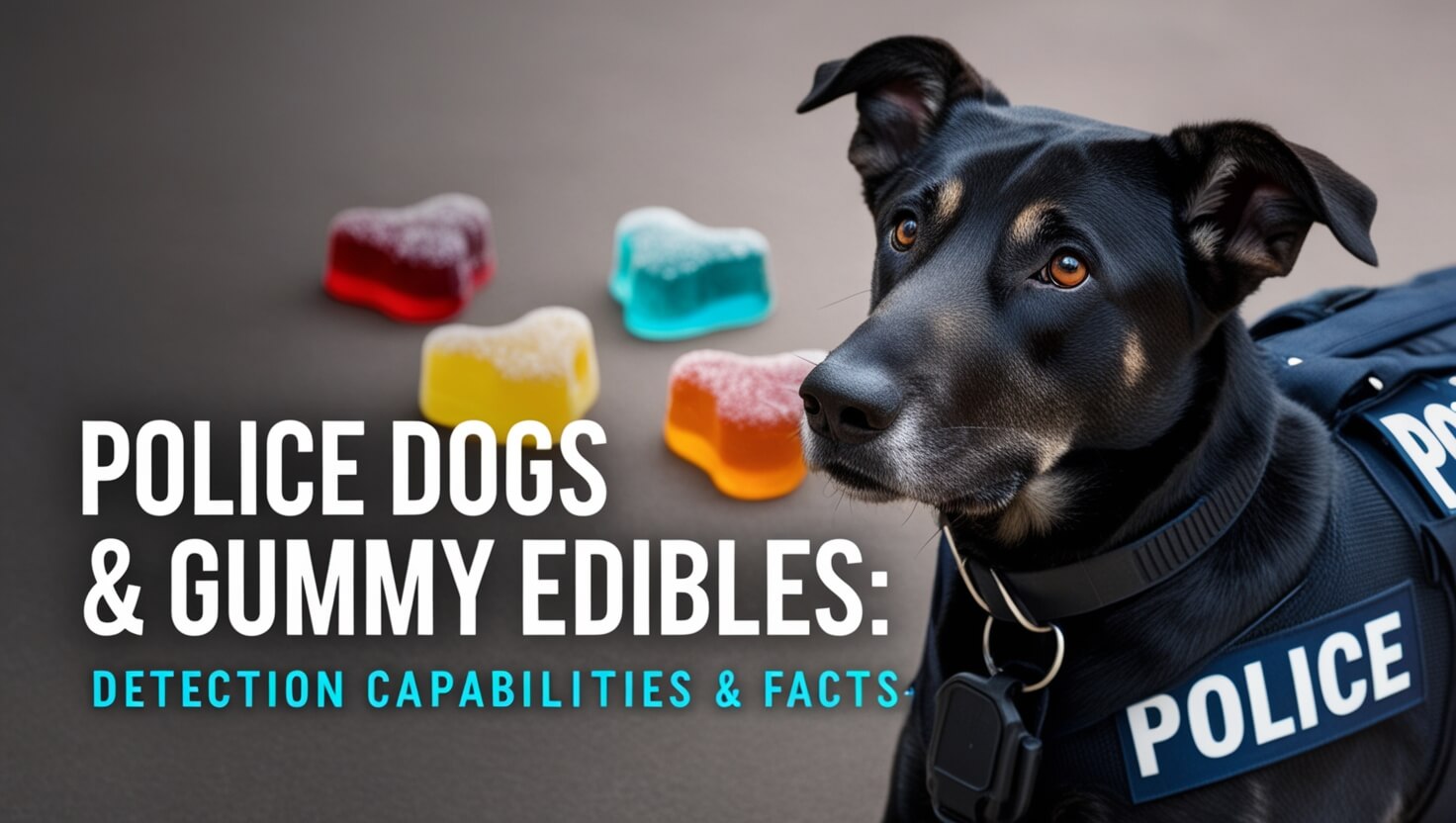Can Police Dogs Smell Gummy Edibles? Detection Capabilities & Facts

Police dogs have an incredible ability to detect THC in gummy edibles. Their powerful noses pick up even tiny traces of THC, no matter how well you think they’re hidden. These highly trained K9 units serve as one of law enforcement’s most effective tools for finding concealed cannabis products.
How Police Dogs Detect THC in Gummies
A dog’s nose works like a superpower compared to human smell. Police dogs have up to 300 million smell receptors, while humans only have about 6 million. This makes their sense of smell 10,000 to 100,000 times stronger than ours.
The Science Behind a Dog’s Nose
The canine nose breaks down every scent into tiny parts. Think of it like a high-tech scanner that separates each smell into its basic elements. When a police dog sniffs the air, it can pick out individual scents from a complex mixture, just like you can hear individual instruments in an orchestra.
Their noses detect specific odor molecules that THC releases. Even when mixed into sweet, fruity gummy bears or other edibles, these molecules still float through the air. The strong food smells that mask THC from human noses don’t fool these sophisticated canine sensors.
Police Dog Training Methods for THC Detection
K9 units learn to find drugs through careful training that rewards them for finding target scents. Trainers teach dogs to associate the smell of THC and other substances with their favorite toys or treats. This creates a powerful drive to search for these scents.
During training, dogs practice finding drugs hidden in various forms:
- Raw cannabis
- Concentrates
- Edibles like gummies
- Pills and capsules
- Sealed packages
They learn to alert their handlers by specific actions like:
- Sitting down
- Pawing at the source
- Barking
- Changing their body posture
Success Rates of K9 Drug Detection
Well-trained police dogs show remarkable accuracy in finding hidden drugs. Their success comes from:
- Natural hunting instincts
- Thousands of hours of training
- Strong bonds with handlers
- Regular practice and certification
Why Gummy Edibles Don’t Fool Police Dogs
Many people think sweet gummy flavors mask THC from drug dogs. This common myth ignores how differently dogs process smells compared to humans.
Breaking Down Complex Scents
Police dogs don’t smell one unified scent like we do. Their brains process each ingredient separately:
- The fruit flavoring
- The gelatin base
- The sugar coating
- The THC compounds
No matter how strong the fruity smell seems to us, dogs still detect the THC molecules underneath. It’s like they have x-ray vision for smells.
Food Scents vs Drug Scents
Regular food smells don’t distract trained police dogs. They learn to ignore food odors and focus only on target drug scents. Even hungry dogs maintain this training because they know rewards come from finding drugs, not snacks.
The Myth of Masking Agents
Strong-smelling foods or spices don’t hide THC from police dogs. Their noses easily separate:
- Multiple scent layers
- Mixed ingredients
- Attempted masking agents
Factors That Impact K9 Detection of THC Gummies
Several things affect how easily dogs find THC gummies, but none make detection impossible.
Packaging Types and Their Effects
Different packaging materials impact scent dispersal:
- Plastic bags let more smell escape
- Glass containers trap some odors
- Vacuum sealing slows scent release
- Multiple layers create barriers
But no packaging completely blocks THC molecules from reaching a dog’s nose. Scents eventually leak through tiny gaps or permeate materials.
Temperature and Environmental Conditions
External factors influence scent detection:
- Heat increases molecule movement
- Cold slows scent dispersal
- Wind carries molecules farther
- Humidity affects scent strength
Professional K9 teams train in all conditions to maintain reliability year-round.
THC Concentration Levels
Higher THC amounts create stronger scents. However, police dogs can detect even trace amounts. Their sensitive noses pick up:
- Low-dose edibles
- Single gummies
- Residual amounts
- Partial pieces
Age and Freshness of Edibles
Older edibles may have weaker scents, but dogs still detect them. THC molecules continue releasing over time, though intensity may decrease.
Different Types of Police Dogs and Their Abilities
Law enforcement agencies use various breeds for drug detection work.
Common Breeds Used for Drug Detection
Top choices include:
- German Shepherds
- Belgian Malinois
- Labrador Retrievers
- Springer Spaniels
- Beagles
Each breed brings unique strengths to detection work.
Specialized Training Programs
Police dogs typically learn 6-8 specific drug scents. Training focuses on:
- Scent recognition
- Search patterns
- Alert behaviors
- Handler communication
- Environmental adaptation
How Handlers Work with K9 Units
Success depends on strong handler-dog partnerships. Handlers:
- Read subtle behavior changes
- Guide search patterns
- Maintain training standards
- Ensure dog welfare
- Document findings properly
Where You’ll Encounter Drug Detection Dogs
K9 units work in many settings where they might detect THC gummies.
Airport Security Protocols
Airport dogs focus mainly on explosives rather than THC. However:
- Some dogs still screen for drugs
- Federal laws affect air travel
- State laws vary widely
- International flights face stricter rules
Public Events and Venues
K9 teams often work at:
- Music festivals
- Sports events
- Large gatherings
- Public transportation hubs
- Entertainment venues
Traffic Stops and Vehicle Searches
Police may use dogs during traffic stops to:
- Circle vehicles
- Sniff external air
- Check cargo areas
- Search passenger spaces
School and Campus Security
Many schools employ K9 units to:
- Conduct random searches
- Check lockers
- Monitor parking lots
- Inspect common areas
The Latest Technology in K9 Drug Detection
Modern tools enhance traditional K9 capabilities.
Modern Training Equipment
New tools improve training:
- Scent walls
- Variable hiding spots
- Scent detection boxes
- Remote rewards systems
Electronic Nose Devices
New technology supplements K9 work:
- Chemical sensors
- Portable analyzers
- Digital scent processing
- Automated detection systems
Ongoing Research and Developments
Scientists continue studying:
- Scent detection limits
- New training methods
- Handler-dog communication
- Environmental factors
Legal Aspects of K9 Drug Detection
Understanding your rights helps navigate K9 encounters.
Search and Seizure Laws
K9 searches must follow legal guidelines:
- Probable cause requirements
- Search warrant rules
- Privacy protections
- Evidence handling procedures
State vs Federal Regulations
Laws vary between jurisdictions:
- Federal cannabis prohibition
- State legalization differences
- Local enforcement policies
- Cross-border considerations
Your Rights During K9 Searches
Know your basic rights:
- Consent requirements
- Search limitations
- Documentation needs
- Legal representation options
Common Myths About Police Dogs and Edibles
Many misconceptions exist about K9 detection abilities.
Popular Misconceptions
Common myths include:
- Food smells block detection
- Sealed containers prevent detection
- Dogs only find raw cannabis
- Low doses go undetected
Scientific Facts vs Fiction
Research shows:
- Dogs detect minute amounts
- Packaging doesn’t block all scents
- Food odors don’t prevent detection
- Training overcomes distractions
Real-World Detection Cases
Actual cases prove K9 effectiveness:
- Regular successful finds
- Various concealment methods
- Different environments
- Multiple product types
Police dogs can indeed smell THC gummies and other edibles. Their incredible noses, combined with thorough training, make them highly effective at finding hidden cannabis products. No amount of flavoring, packaging, or masking agents reliably fools these skilled K9 units.






